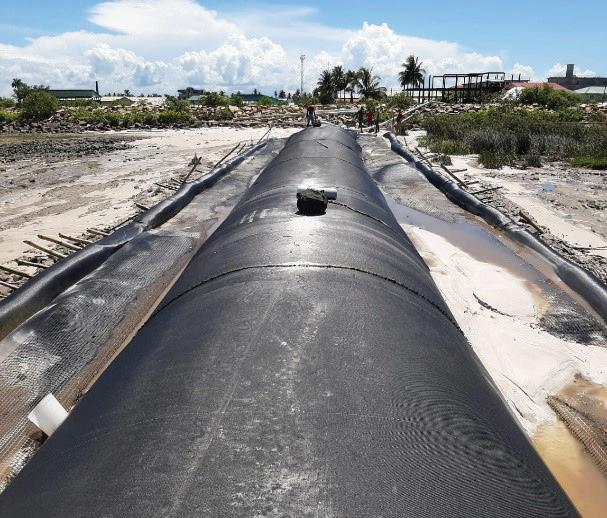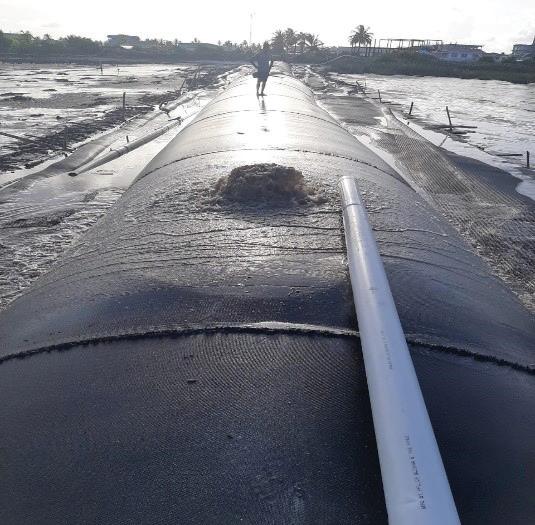
5 minute read
Mangrove Restoration- A Necessary Climate Mitigation Solution-Mark Ram & Shaleeza Shaw
manGroVe resToraTIon-a necessary clImaTe mITIGaTIon soluTIon - mark ram and shaleeza shaw
MARK RAM SHALEEZA SHAW Commensurate with UNESCO, we need to raise awareness of the importance of mangrove ecosystems. Mangroves are special as they are tropical trees that thrive in conditions most timber cannot withstand -salty, coastal waters, and
the interminable ebb and flow of the tide, all common to Guyana and its riverain locations. Mangroves provide important ecosystem services such as coastal protection, climate mitigation,carbon storage and sequestration and support fisheries. Of critical importance is mangrove’s carbon sequestration ability which is laudable as they are known to have higher carbon mass ratios than other terrestrial trees in the tropics.
Mangrove forests are key weapons in the fight against climate change, but sadly, they are under threat worldwide and here at home, despite their promotion as a fairly lowcost solution for sustainable management and conservation.
Guyana was known have substantial mangrove cover which have been depleted by coastal erosion and development . However, there has been much effort and projects undertaken to support mangrove restoration so much so that today our inventory indicates that we have some 82,437 acres of mangroves. But is that enough? The environmentalists will tell you without hesitation, no.
The Guyana Mangrove Restoration Programme from 2010 -2014, which was supported by the European Union (EU) and the National Agricultural Research and Extension Institute (NAREI), resulted in over eleven (11) km of replanted mangroves (] 500,000 seedlings), and 40 km placed under special protection, which though laudable, should not make us complacent. Mangrove restoration efforts should be amplified in Guyana, especially as the country confronts the raft of rising sea levels and unprecedented coastal development.
Conservation of existing mangroves is also crucial as the threats of erosion become violent, and the destruction of local mangroves continues, especially in Region 1 and the East Coast corridor of Region 4. Therefore, there is scope for ecosystem services protection by considering the EU’s proposal to establish a 700 km2 Mangrove Forested Area in the Barima and Mora Passage rivers, which is adjacent to the Shell Beach protected area in Region 1. Other areas with standing mangrove forests should be identified and placed under special protection schemes such as protected areas or nature reserves. In a recent study in July 2021 titled: Mangrove Forest Restoration Efforts Find Success in Newly Planted Seedlings, led by University of Guyana graduate faculty, Mark Ram, and co-authored by fellow Guyanese Anand Roopsind based at Conservation International, compared the restored conditions to those of both intact and degraded forests. The research team found that restored forests yield 13% more aboveground vegetation – consisting of mangrove trees’ leaves, twigs, branches and stems – than mangrove forests which remained intact over the past decade. The restored sites have 99% more of this vegetation than degraded sites that had not been restored.
“These results are very encouraging – they help us make the case that mangrove restoration is a necessary practice to ensure these carbon storing ecosystems thrive for years to come,” said Roopsind. “We now know that, with the proper technical knowledge, mangrove plantings can grow back relatively quickly and even lead to healthier mangrove forests overall.”
With coastal development and deforestation leading to the widespread loss of mangrove forests, planting new seedlings has emerged as the leading strategy to regain some of the forests’ ecological benefits – like the critical role they play as fish nurseries and their carbon storage ability, which is higher by area than old-growth forests.

© Deopaul Somwaru - Restored mangroves at No 7., Region 5
“Not only are mangroves good for our climate, these forests are vital to coastal areas in the tropics. In Guyana, they provide a protective buffer against storms and sea-level rise and act as critical nursery habitats for many seafood species. They are essential for the well-being of so many local communities,” said Mark Ram, co-author of the paper from the University of Guyana.
manGroVe resToraTIon-a necessary clImaTe mITIGaTIon soluTIon - mark ram and shaleeza shaw
The pictures below are from the Anna Regina Geotube installation for the protection of mangroves.

© Mario Amres-June 2020

Wave action has long been a problem for many beaches and agricultural communities as it can erode beaches.The geotextile tube system allows for a combination of technology with the traditional seedling planting. It acts as a “breakwater” structure and is placed offshore in the area where wave action is causing damage. Geotextile tubes reduce the wave energy by breaking on the system. As a result, the water conditions on the protected side of the breakwater remain relatively calm. Sand-filled geotextile tube systems are a more cost-effective solution compared with a typical rockfilled core breakwater where rock is expensive and difficult to source at project region, and where the sea condition is not extreme.
As Guyana embraces an oil and gas sector and adopts to changing climatic conditions, the importance of both mangrove conservation and mangrove restoration cannot be overemphasized. Recent breaches of our coastline underscore their importance and value to the socioeconomic strata of Guyana’s development, and, of course, their aesthetic beauty.

We need to have a broader view of the interconnectivity of Guyana’s coastal biodiversity and their effective management for present and future generations, as we concurrently encourage economic development. Greater support for mangrove conservation and restoration is crucial to offset the impacts of economic and infrastructure development in Guyana.
Mark Ram is a Lecturer with the Department of Biology, University of Guyana.He holds a PG Dip (2019) Higher Education; MSc (2018) Forest Biology; and BSc (2016) Biology, University of Guyana.
Shaleeza Shaw is the Manager of Demerara Bank Limited’s Main Branch, and the Secretary of GCCI as well as the Chairperson of the Chambers Green Economy Committee. She holds a in Diploma in Banking and Finance, a Bachelor of Social Sciences in Business Management and a Bachelor of Laws (all with distinction) from the University of Guyana. Ms Shaw is also a Certified Credit Professional with Jamaica Institute of Financial Services & The Chartered Institute of Bankers in Scotland and holds a Master in Business Administration - Chartered Banker (with Distinction) from The Bangor University, Wales.














